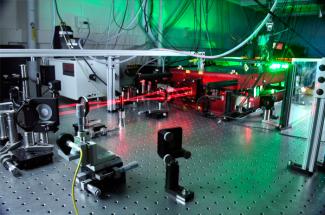Fellows Steve Cundiff and Ralph Jimenez have created two precision optics instruments with a priceless potential for shedding light on condensed-matter and biological physics. Instrument shop staffer Kim Hagen aided and abetted them in their endeavor by creating exquisite CAD drawings and machining precision parts.
After three years of development, the Institute is now home to two JILA MONSTRs (Multidimensional Optical Nonlinear SpecTRometers), one of which is helping researchers in the Cundiff group peer into the nanoscopic workings of semiconductor quantum wells. The other will soon allow the Jimenez group to compare myoglobin with heme proteins in plants. The comparison will be critical for the production of biofuels.
A MONSTR is a compact, ultrastable optical platform machined out of two cast aluminum plates. Sandwiched between the plates are three cascaded and folded interferometers. Together these interferometers split an incoming coherent laser pulse into a box of four identical pulses. The travel time of each pulse through the MONSTR can be exactly set to allow a well-defined sequence of three pulses to interact with a sample. Researchers can then generate a signal that can be recorded as a function of one, two, or, possibly, three time dimensions. A Fourier transform converts sets of time data into multidimensional frequency spectra. These spectra are much easier to interpret than those produced by other methods.
The MONSTRs are colorful creatures. The Cundiff MONSTR is fed with a high-intensity infrared laser that is bright enough to detect visually. The Jimenez MONSTR is nourished with bright green laser pulses. The MONSTRs also get some of their internal color from a red helium-neon laser beam. The HeNe beam traces the same path as the infrared or visible pulses and is used as a ruler to set the length of each pulse’s time steps in the three interferometers. Beautiful red anodized-aluminum plates stabilize the MONSTRs’ guts and form their exoskeletons.
The JILA MONSTR uses a sequence of coherent laser pulses to excite particular frequencies of the electronic polarizations inside a material. The process is like hitting a bell with a hammer several times in succession while changing the spacing between the hammer strikes in near perfect increments. The hammer pattern sets up coherent interference patterns that deaden some tones in the bell’s ring and amplify others. The resulting ring-tone pattern contains information about the structure and dynamics of the bell. Similarly, laser-induced frequency patterns created in semiconductor quantum wells or in protein active sites allow JILA researchers to deduce the structural and dynamical behavior of electrons at the nanoscale.
In MONSTR experiments, subwavelength stability is critical. Thus the hard part of this kind of experiment is getting the right spacing between the pulses. The MONSTR meets the challenge with a computer-controlled diagnostics program that forces all four pulses to maintain the same relative phase for any set of time delays. In the process, the MONSTR makes automated two-dimensional (2D) Fourier transform spectroscopy measurements possible. With it, researchers can obtain a full 2D spectrum in about 20 minutes. It takes just a few hours to obtain a set of 2D spectra for different experimental conditions in which such parameters as polarization or temperature are varied to probe specific interactions in the sample.
In the Cundiff lab, the JILA MONSTR has proven to be a leap forward in optical research into nanoscopic light-matter interactions. Its application to solid state and (in the near future) dense vapors will cast a new light onto complex interactions and yield insight into quantum coherent phenomena that are at the heart of physical, chemical, and optical science research. - Julie Phillips




